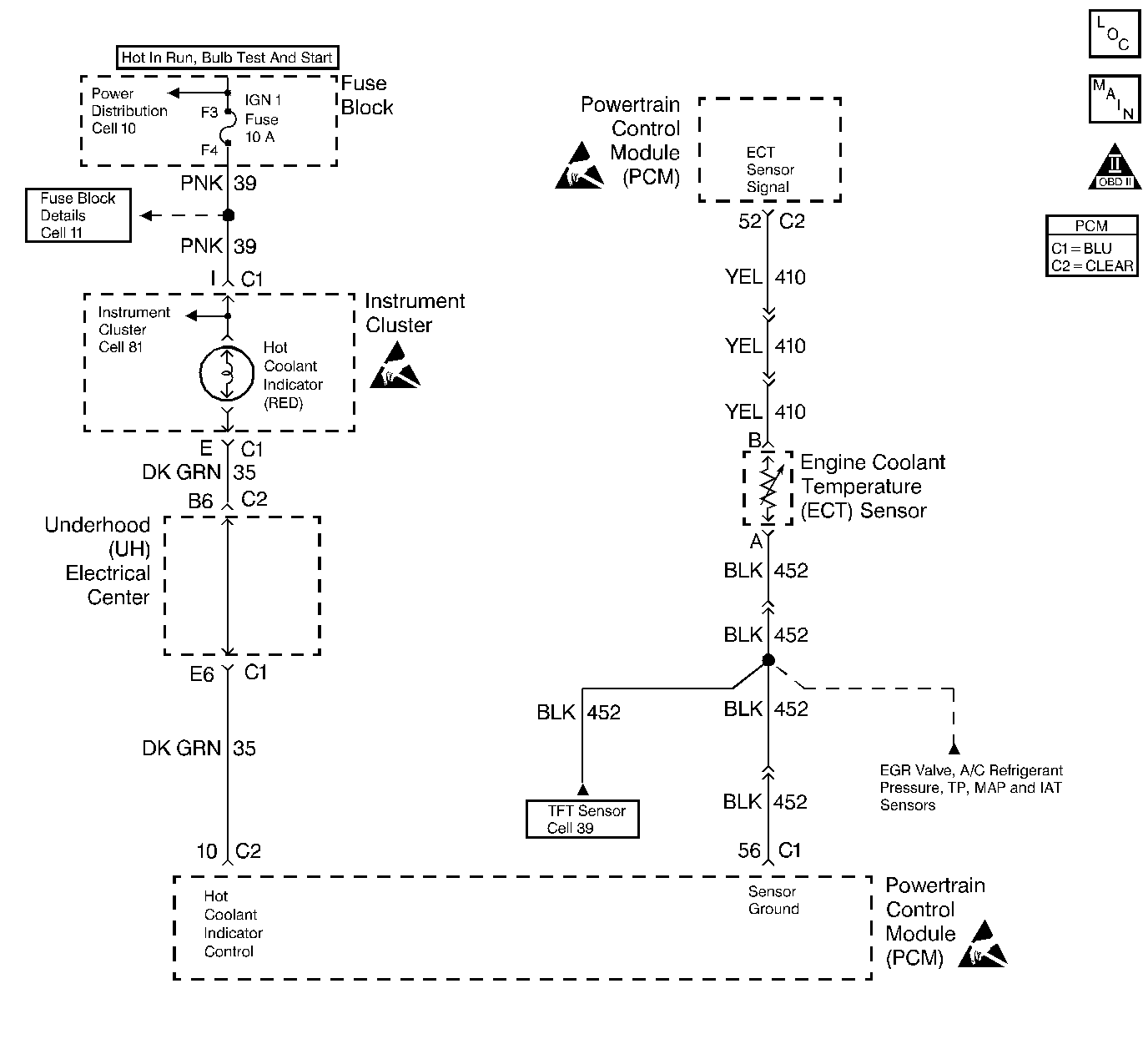
Circuit Description
To provide the best possible combination of driveability, fuel economy, and emission control, a closed loop air/fuel metering system is used. When the vehicle is first started, the PCM controls fuel delivery in open loop, ignoring the heated oxygen sensor HO2S 1 signal and calculating air/fuel ratio based on inputs from the engine coolant temperature, throttle position, and mass air flow sensors. The PCM will begin using the HO2S 1 signal for controlling fuel delivery (Closed Loop) when the following conditions have been met:
| • | The HO2S 1 signal is varying, indicating that the sensor is hot enough to operate properly. |
| • | The engine coolant temperature sensor indicates coolant temperature above 20°C (68°F). |
| • | Time since start-up is at least 16 seconds for a warm engine or 50 seconds for a cold engine. |
Conditions for Setting the DTC
| • | No IAT or ECT sensor DTC(s) present. |
| • | Intake air temperature is greater than 10°C (50°F). |
| • | Start-up engine coolant temperature is between 10°C (50°F) and 30°C (62°F). |
| • | Engine coolant temperature sufficient to allow Closed Loop operation (22°C /71.6°F) is not achieved within 2 minutes of start-up. |
Action Taken When the DTC Sets
| • | The PCM will illuminate the malfunction indicator lamp (MIL) during the second consecutive trip in which the diagnostic test has been run and failed. |
| • | The PCM will store conditions which were present when the DTC set as Freeze Frame and Failure Records data. |
Conditions for Clearing the MIL/DTC
| • | The PCM will turn OFF the MIL during the third consecutive trip in which the diagnostic has been run and passed. |
| • | The History DTC will clear after 40 consecutive warm-up cycles have occurred without a malfunction. |
| • | The DTC can be cleared by using the scan tool. |
Diagnostic Aids
The DTC P0125 diagnostic test will not run if the engine is started while the coolant temperature is less than 10°C (50°F) or greater than 22°C (71.6°F). If it is not possible to operate the vehicle under the appropriate conditions, check the following items:
| • | Cooling system coolant level, (refer to Cooling and Radiator). |
| • | Thermostat operation (refer to Cooling and Radiator). |
| • | Cooling fans operation. Refer to Electric Cooling Fan Diagnosis . |
| • | Check for high resistance in wiring related to the ECT sensor. Also, check for poor connections at ECT sensor and PCM. Refer to Troubleshooting Procedures in Electrical Diagnosis. |
| • | DTC P0125 set indicates a slewed ECT sensor. Comparing the engine coolant temperature displayed on a scan tool with actual coolant temperature measured with a thermometer may isolate this condition. If the displayed engine coolant temperature is not close to the actual coolant temperature, replace the ECT sensor. Refer to Engine Coolant Temperature Sensor Replacement . |
| • | Poor connection at PCM. Inspect harness connectors for backed out terminals, improper mating, broken locks, improperly formed or damaged terminals, and poor terminal to wire connection. |
| • | Damaged harness. Inspect the wiring harness for damage. If the harness appears to be OK, observe the display on the scan tool while moving connectors and wiring harnesses related to the sensor. A change in the display will indicate the location of the fault. |
If DTC P0125 cannot be duplicated, the information included in the Fail Records data can be useful in determining vehicle mileage since the DTC was last set.
Test Description
An example test description follows:
Step | Action | Value(s) | Yes | No |
|---|---|---|---|---|
1 | Was the Powertrain On Board Diagnostic (OBD) System Check performed? | -- | ||
Does Eng. Cool. Temp. increase to above the specified value within 2 minutes? | 21°C (70°F) | Go to Diagnostic Aids | ||
3 | Are any ECT sensor DTCs set? | -- | ||
4 |
Are the cooling fans off? | -- | ||
5 | Check the cooling system coolant level. Refer to Cooling and Radiator. Is the coolant level OK? | -- | ||
6 | Check for proper operation of the thermostat . Refer to Cooling and Radiator. Is the thermostat operating correctly? | -- | ||
7 | Compare Eng. Cool. Temp. displayed on the scan tool to the actual coolant temperature measured with a thermometer. Is the scan tool Eng. Cool. Temp. indication within the specified value of the measured temperature? | ±3°C (±5°F) | ||
8 | Check for high resistance in wiring related to the ECT sensor. Also, check for poor connections at the ECT sensor and at the PCM. Refer to Troubleshooting Procedures in Electrical Diagnosis. Was a problem found? | -- | ||
9 | Refer to Cooling and Radiator for cooling system diagnosis and repair condition as necessary. Is the action complete? | -- | -- | |
10 | Replace the faulty terminal(s) or repair faulty wiring as necessary. Refer to Repair Procedures in Electrical Diagnosis. Is the action complete? | -- | -- | |
11 | Replace the ECT sensor. Refer to Engine Coolant Temperature Sensor Replacement . Is the action complete? | -- | -- | |
12 |
Does Eng. Cool. Temp. increase to above the specified value within 2 minutes? | 21°C (70°F) | System OK |
